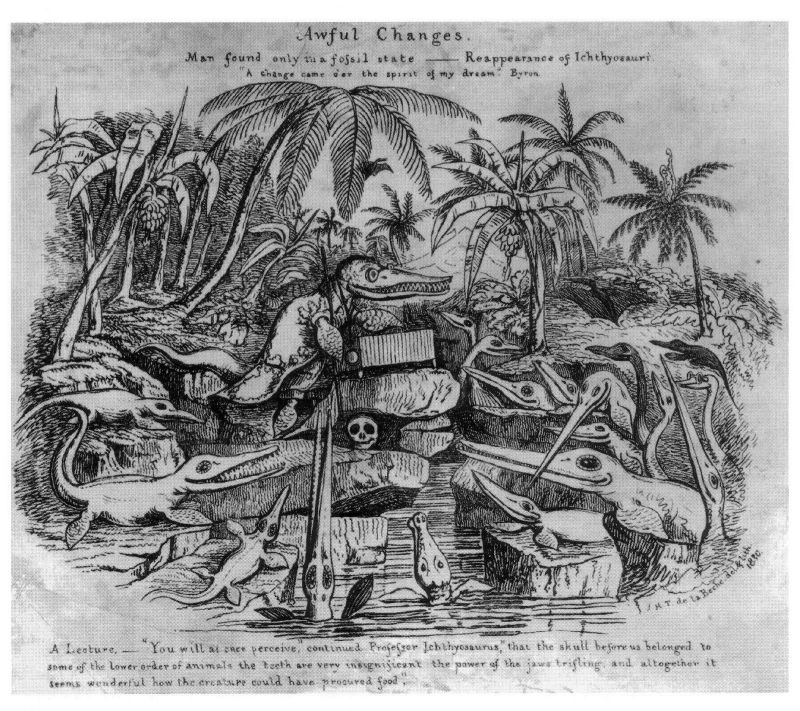|
|
Historical discovery
of Deep Time |
| Time |
Historical discovery
of Deep Time |
Historical discovery of Deep Time
A very brief history of humanity's explanations regarding the Age of the Earth

"You will at once perceive,' continued Professor Ichthyosaurus, 'that the skull before us belonged to some of the lower order of animals; the teeth are very insignificant, the power of the jaws trifling, and altogether it seems wonderful how the creature could have procured food."
(caricature by De la Beches of Charles Lyell as Professor Ichthyosaurus on the pages of Francis Trevelyan Buckland (Son of William B.). Curiosities of Natural History.
The concept of linear time, evolution and extinction were so radically different to premodern concepts of time (such as the cyclic worldview) that for a long time even secular scientists held to a hybrid cyclic worldview. Hence, like Hutton before him, Lyell adopted the idea of geological time as a cycle, albeit an immensely long one, complete with seasons and climate variation of a "geologic year". Like other 18th and early 19th century scientists, Lyell denied the possibility of extinction (he also was for a long time opposed to evolution), and so, he asseryed, given climatic change thorough geological seasons, it was possible that
"Then might those genera of animals return, of which the memorials are preserved in the ancient rocks of our continents. The huge iguanodon might reappear in the woods, and the ichthyosaur in the sea, while the pterodactyl might flit again through the umbrageous groves of tree ferns."
This vision of cyclic time inspired one of most famous caricatures in palaeontology, drawn by geologist Henry de la Beche (1796 -1855), who imagined a palaeontology lesson in a distant, steamy tropical Mesozoic future, in which giant marine reptiles discuss the inferiority of strange creatures with weak jaws and small teeth from a bygone age.
In order to understand the evolution of life, the Earth, and the cosmos as a whole, we need to understand deep time. In other words, it is necessary to think in terms of millions, tens or hundreds of millions, or even billions of years, in other words, in terms of Deep Time. Geologists pioneered the discovery of Deep Time in the 18th and 19th century, overthrowing the ridiculously short biblical timescales that were standard until then, although the new science was not without a few eccentricities of its own, as indicated above. Their work was further taken up by astronomers and physicists speculating on the age of the universe.
Before describing Deep Time itself, a two part history is presented here. The first, which doesn't have anything to do with science, simply describes a few of the very different concepts of time and history that were around prior to the scientific revolution modern geology. As even today we can talk in terms of historical time, mythological time, psychological time, and so on, many of these are still valid. The second, of more relevance to the present topic, very briefly (mostly cheating here, i.e. copying from Wikipedia) overviews the origin of the modern stratigraphic or geological column, a diagram which, like the periodic table of elements, the big bang diagram, and the tree of life, is one of those classic motifs of contemporary scientific iconography
Alternatively, you may wish to skip all this superfluous introduction and jump straight to the Geological Timescale MAK110829

Unless
otherwise noted,
all original text on this page may be used under the terms of a
Creative Commons License.
However, all graphics on this page are copyright their original author or publisher, apart from those indicated to be
public domain or open source license
